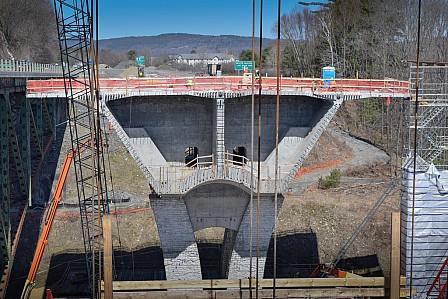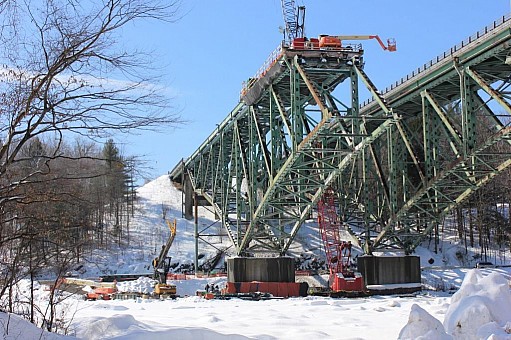July 18, 2017
A New Bridge Rises
If you’ve travelled north to Vermont from the Massachusetts state line over the past few years, chances are good that you got stuck in traffic on I-91 due to construction of a new bridge in Brattleboro. I’m happy to report the new 1,036-foot, three-span segmental bridge is now open to both northbound and southbound lanes of I-91. The new bridge, which crosses over the West River, is an arching concrete bridge which utilizes balanced cantilever construction. It rises 100 feet above the scenic river valley.
Prior to bridge construction, a “Visual Quality Advisory Team” was put together, consisting of Vermont Agency of Transportation, a local aesthetic committee, and FIGG Bridge Engineers Inc. The state and bridge designers worked with the local community to establish design criteria to include the unique curving, along with more “earth-friendly” color for boaters and hikers viewing from underneath the bridge. There are hiking trails which run along the West River and under the new bridge.
The new bridge also has viewing platforms for pedestrians, hikers and visitors at the base of each pier overlooking the West River and Valley. Of course, this being Vermont, the bridge, with its viewer- and environmentally-friendly design, has been named “A Bridge to Nature.”
Despite the traffic jams, it’s been fascinating watching the construction of the new bridge. The $60 million project began in the fall of 2013 and replaces two existing separate truss bridges built in the 1950's. These bridges were deemed structurally deficient, hence the replacement.
Segments of the new bridge were cast with a machine called a “form traveler”. According to Wikipedia, a “segmental bridge” is a concrete bridge built in short sections, one piece at a time, as opposed to traditional methods that build a bridge in very large sections. Forming and reinforcing the curving cathedral piers is apparently quite complex and resulted in the project being delayed several months past its original time frame. Hence the frustrated tourists.
The balanced cantilever construction consists of 56 million pounds of concrete, 1,100,000 pounds post tensioning (prestressing steel cables), and 3,000,000 pounds rebar (including 900,000 stainless).
The project also included replacement of a smaller bridge nearby that carries the northbound and southbound lanes of I-91 over Upper Dummerston Road. This bridge uses “NEXT beams”. NEXT beams are made of steel and provide an alternative to concrete box beams for 30-feet and 90-feet spans. NEXT beams are considered a time- and money-saver in modern bridge construction.
Scrap the Old
History venerates the builders of great bridges, dams, and towers. But rare are commemorative plaques for the un-builders—those charged with the equally heroic task of dismantling those grand structures, once they become dowdy, obsolete, or downright dangerous. - Wired
According to Wired, the demolition of the old span of the San Francisco-Oakland Bay Bridge in 2013 cost an estimated $240 million. Just the cantilever truss of the old Bay Bridge was made of 50 million pounds of steel.
The old northbound I-91 bridge over the West River was removed early in the construction phase of the new bridge. The old southbound bridge has been being dismantled since the opening of the new bridge this past spring. I don’t know at what cost, but it has been quite exciting to watch!
To dismantle a bridge requires careful planning. Different techniques are required to dismantle different materials. For concrete, demolition is done using explosives, jackhammers, and bursting (which involves applying pressure or injecting chemicals to break apart concrete). For steel bridges, like the I-91 bridge, it is done through dismantling.
Dismantling steel is done through sawing, water jetting, or thermic lance. For sawing, enormous saws and cranes are used to cut through and remove bridge steel. Demolition saws often contain diamonds in order to handle these types of demolition jobs.
If water jetting is used, extremely high pressures (50,000 PSI or more) are required to dismantle bridges. Water jetting helps to reduce fire hazard, dust, and damage to surrounding materials. Thermic lancing, another dismantling technique, uses specialized torches that melt through steel, cutting it into smaller chunks that can then be hauled away.
First, the tension of the cantilever has to be reduced. Workers start by removing the pavement to lighten the bridge’s load and reduce the tension. Next steel supports are isolated and jacked out of tension before cutting. Next the truss spans are dismantled, cut into small pieces and removed. Finally, the foundation is dismantled.
Demolition contractors who dismantle steel bridges frequently specialize in scrap metal demolition. Steel can be recycled repeatedly without losing its structural strength. So, who knows what will become of the old I-91 bridge, but I’m happy knowing it’s going to a new home!
By Athena Lee Bradley






Comments (0)
Add a Comment